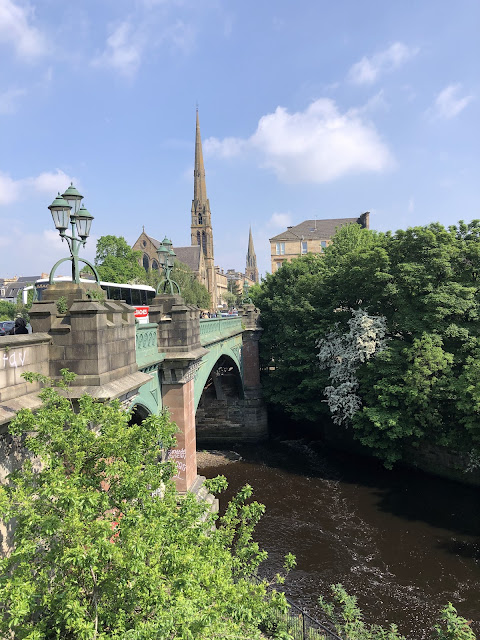Glasgow feels different than Scotland's other big city, Edinburgh. Edinburgh's layout is either ancient/ quixotic (the old city) or aristocratic (the new city). Glasgow is all faded empire and restored tenements. The buildings in Merchant City in Glasgow are testaments to Glasgow's absurd wealth at the height of the British empire--architectural flourishes adorn every building, each one trying to outdo the next--but it's the lack of modern skyscrapers that I love the most. Nothing rises above the height of 19th century building standards. Glasgow also feels gritty. Without romanticizing poverty, Glasgow was a working class town, and there remains visible evidence of working class life in the 19th and 20th centuries. Recently, Glasgow has developed one of the most remarkable arts cultures of any city I've ever visited. There are galleries, art schools, music venues, theater--big ones, little ones, for profit, non-profit. And people patronize the arts here. When I arrived on Wednesday, I looked for some kind of entertainment on Thursday. The Scottish Symphony was sold out; the modern ballet was sold out; the techno-folk act was sold out. I was both pissed off and delighted.
On Thursday, I had a terrific meeting with staff from the Church of Scotland's Priority Areas Initiate. I'll write a separate post about that meeting and about why I'm studying the PAI and what I hope to borrow from it for the Presbytery of Greater Atlanta.
But I've also spent the two days exploring (on foot, the way every city should be explored) Glasgow. Glasgow is a river city. The main river is the Clyde, which runs through the heart of Glasgow and was the center of Glasgow's famous shipbuilding and merchant culture. Glasgow's not technically a port, but the Clyde functioned like one. I explored the Clyde last summer. This time, I explored a tributary, the Kelvin. The Kelvin cuts through a neighborhood west of downtown that has one of the most engaging museums I've ever been to (Kelvingrove), the Glasgow Botanic Gardens, and Glasgow University (which dates, like St. Andrews, to the 15th century). I can't tell you how serene it is to find this in the middle of a city:
I headed out to this neighborhood for an arts event. Every year during the month of May, there's a theater festival here called, "A Play, a Pie, and a Pint." For $20, you get admission to a new work of theater, and you are served a meat pie and a pint of Tennent's beer. At 1PM, the theater was completely full--about 150 people, I'd guess. Again, I can't even comprehend this level of support for the arts. It's magnificent. The play I saw, Roost, is a two-person show that focuses on social worker paying a visit to man who may lose custody of his daughter, in part because of his all-consuming hobby of pigeon-keeping--a hobby that he has come to view with spiritual and existential meaning. I should note that the theater is in the basement of a converted church--one of many beautiful church buildings in Glasgow that has been re-purposed for post-Christendom. It's hard to say that this wasn't a kind of experience of church.
After the play ended, I meandered my way back to the center of Glasgow, first through the Botanic Gardens and the pathways along the Kelvin. I noticed this sign, which is another part of Glasgow that I love--the graffiti, street art, and socialist history. The spray painted sign says: "landlords are leeches!" Look more closely at the handwritten tag: "not fair on leeches!" Glasgow has a cheekiness.
Great Western Avenue has some beautiful shops and restaurants. Two of my favorite things: peonies and cheese:
I made my way up to the top of the city, to a place called the Hamiltonhill Claypits. Scotland's engineering legacy is truly breathtaking. In the 18th century, the Scots built a cross-country canal to expedite shipping. The Forth and Clyde Canal still exists, and in many places, it has been restored as a recreation area. The Hamiltonhill site was a formerly industrial area where they dug a special kind of clay that was waterproofing for the bottom of the canals themselves. There was a ton of signage about how the canals are being used these days to address ecological and hydrological issues. The Hamiltonhill site has a great view of the city of Glasgow, but as it's up on a hill, they've built some play spaces along the way up. American insurance companies would never allow a slide like this!








No comments:
Post a Comment